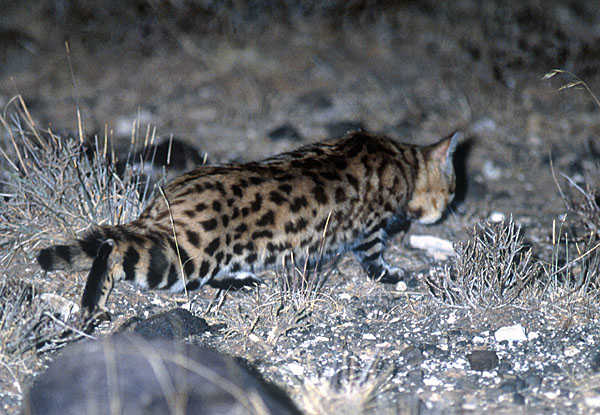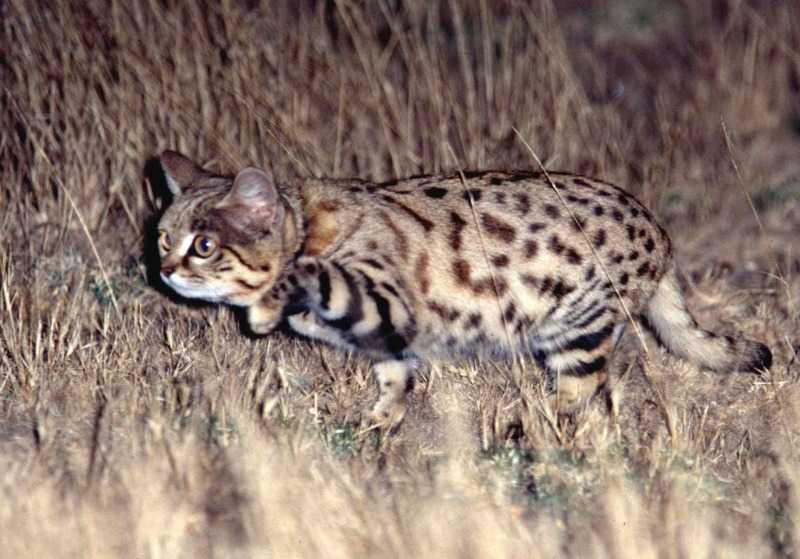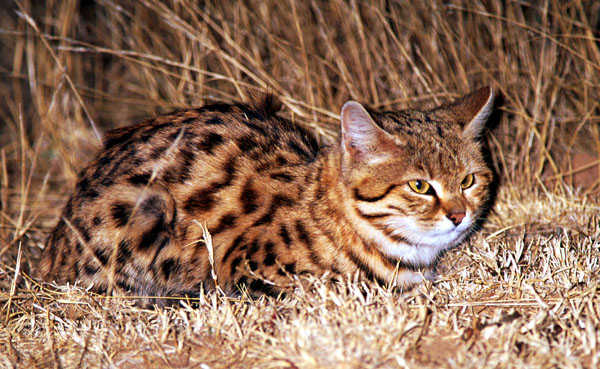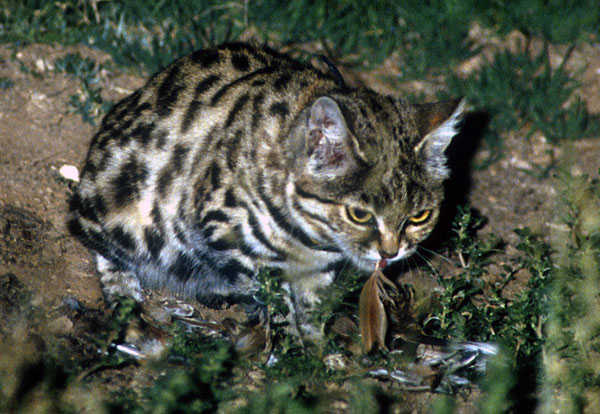With their immense home ranges, Black-footed Cats spend about 70% of the night hunting. They move between 4.5 and 16 km, averaging 8.5 km per night. These distances represent odometer readings of the tracking vehicle, while 16 km moved by the truck would correspond to more than 30 km moved by the cat zig-zagging between bushes and termite mounds.
These mini predators utilize three hunting styles:
The Fast Hunt Moving in swift bounds while flushing prey from cover using the element of surprise and relying mostly on their eyesight.
The Slow Hunt A slow, stalking movement, winding snake-like between the grass tufts, while trying not to move any grass stalks in the process. When using this style, the cat moves its head from side to side, looking and listening carefully, its ears moving in all directions, alert to any movements or sound. When locating a prey animal, the cat started to stalk within 1-2 m trying to determine its exact position, then catching it in a final rush.
The Sit & Wait The cat positions itself at rodent den systems and waits with drawn up front paws for up to an hour. They sometimes close their eyes, but their ears move constantly and when picking up a sound they immediately focus their eyes on the prey. The final rush consists of one or several fast jumps out of the crouch.
The appetite of the Black-footed Cat is extraordinary, and they are quite capable of killing prey larger than themselves. Like many small creatures, they must consume the equivalent of 1/5 their body weight in one night. Males generally take larger prey than the females, but the smaller and more agile females are more successful at catching small birds. They flatten to the ground after hearing a bird, then inch closer, carefully placing each foot so as not to make a sound, before finally making an explosive dash and jump to pluck the bird out of the air. If they do not get the bird on the first try, they often listen to its flight path and follow for a second try.
The cats hunt throughout the night in all weather conditions and temperatures, taking only brief resting periods. Hunting success is very high with about one vertebrate prey animal caught every 50 minutes. On average, 10-14 rodents and small birds are killed in a night. Their diet consists mainly of mammals (72%) and birds (26%), with only 2% falling to spiders, insects and reptiles. Bird’s eggs are eaten by crushing them gently between the jaws and licking the contents clean.
The largest prey animal observed was an adult Cape hare, weighing more than the female who caught it. Prey items too big to be consumed at one sitting are cached inside nearby dens or burrows, and covered with loose sand and grass. These large and rarely taken prey species can feed a cat for up to three nights.
On numerous occasions cats have stalked springbok lambs, between 2-3 kg, lying down waiting for their mother’s return, but never attempted to kill them when they struggled to their feet.
Prey animals in the study area are so plentiful year round and the ground often so hard digging for prey is never observed. The cats do scrape sand and grass over large prey items, and spend long periods grooming, especially after a kill.
During the daylight hours, hunting cats are dive-bombed by small birds which hover 2 m above the cats, spoiling their attempts at hunting. There are seasonal differences in their diet, relating to the occurrence of insects, reptiles and frogs in summer, and young hares in the spring.
See also





Pat Bumstead
I seriously doubt you have a black-footed cat at your door. As you mention, you are hundreds of kilometers from their normal range, and living in a much more humid area than they’re used to. BFC’s do not survive in high humidity. And now having said all that, we do not have a recording of the mating male BFC! If I were you, I would certainly be installing a camera at my front door – living in your location you should likely get a lot of nightly visitors.
Jaco Beyleveld
Good day,
I stay in Westville Kwazulu Natal. Recently I have an unusual feline visiting my house during the night and calling to attract my two young female domestic cats. I have had one sighting and not being properly prepared at 03:00 in the morning, it was not clear and definitive. It appeared to be very similar to the black footed cat but as this is far away from the well documented home range in the drier central parts of the country this would be most unusual. Our yard is situated next to a conservation area that has steep rocky slopes and a constant stream running through it with fish eagles as daily visitors and also breeding in the area, certainly has free access to a wide range of wild animals.
If available would it be possible to forward me a recording of the mating call made by the male black-footed cat. This would certainly assist in identifying my nightly visitor.
Jaco Beyleveld
Love
I love cats